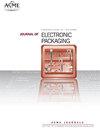高温时效过程中Cu/Cu41Sn11/Cu焊点组织演变及力学性能的研究
IF 2.3
4区 工程技术
Q3 ENGINEERING, ELECTRICAL & ELECTRONIC
引用次数: 0
摘要
研究了Cu/Cu41Sn11/Cu全Cu41Sn11焊点在420℃等温时效过程中组织和力学性能的变化。Cu-Sn金属间化合物(IMC)焊点在第三代宽带隙半导体器件中的潜在应用是其研究的动力。实验结果表明,高温条件下Cu41Sn11相不稳定,热时效150 h时,全Cu41Sn11接头转变为全α(Cu)接头(Cu/α(Cu)/Cu)。形成的α(Cu)相是一种Sn原子浓度不均匀的Cu固溶体,其晶体结构和取向与原始Cu板一致。Cu41Sn11向α(Cu)的转变伴随着由于体积收缩效应而形成的空洞,主要是在焊点界面中部附近。与Cu41Sn11钎料相比,α(Cu)钎料强度降低,应变速率敏感性指数提高。α(Cu)和Cu41Sn11的应变速率敏感性指数低于普通Sn焊料。剪切试验后,Cu41Sn11晶粒出现脆性断裂,而α(Cu)晶粒出现韧性断裂。本文章由计算机程序翻译,如有差异,请以英文原文为准。
Study On the Microstructure Evolution and Mechanical Properties of Cu/Cu41Sn11/Cu Solder Joint During High-temperature Aging
The paper focused on the changes in microstructure and mechanical properties of the full Cu41Sn11 solder joint (Cu/Cu41Sn11/Cu) during isothermal aging at 420°C. It was motivated by potential applications of Cu-Sn intermetallic compounds (IMC) solder joint in third-generation wide bandgap semiconductor devices. Experimental results revealed that the Cu41Sn11 phase was unstable under high-temperature conditions, the full Cu41Sn11 joint transformed into the full α(Cu) joint (Cu/α(Cu)/Cu) joint at 150 h during thermal aging. The formed α(Cu) phase was a Cu solid solution with inhomogeneous Sn atomic concentration, and its crystal structure and orientation were consistent with the original Cu plate. The conversion of the Cu41Sn11 to α(Cu) was accompanied by the formation of voids due to the volume shrinkage effect, predominantly near the middle of the solder joint interface. The α(Cu) solder joint presented a decrease in strength but an increase in strain rate sensitivity index compared to the Cu41Sn11 solder joint. Furthermore, the strain rate sensitivity index of α(Cu) and Cu41Sn11 is lower than that of ordinary Sn solders. After the shear test, the fractures that occurred in Cu41Sn11 grains were brittle, while the fractures in α(Cu) grains were ductile.
求助全文
通过发布文献求助,成功后即可免费获取论文全文。
去求助
来源期刊

Journal of Electronic Packaging
工程技术-工程:电子与电气
CiteScore
4.90
自引率
6.20%
发文量
44
审稿时长
3 months
期刊介绍:
The Journal of Electronic Packaging publishes papers that use experimental and theoretical (analytical and computer-aided) methods, approaches, and techniques to address and solve various mechanical, materials, and reliability problems encountered in the analysis, design, manufacturing, testing, and operation of electronic and photonics components, devices, and systems.
Scope: Microsystems packaging; Systems integration; Flexible electronics; Materials with nano structures and in general small scale systems.
 求助内容:
求助内容: 应助结果提醒方式:
应助结果提醒方式:


